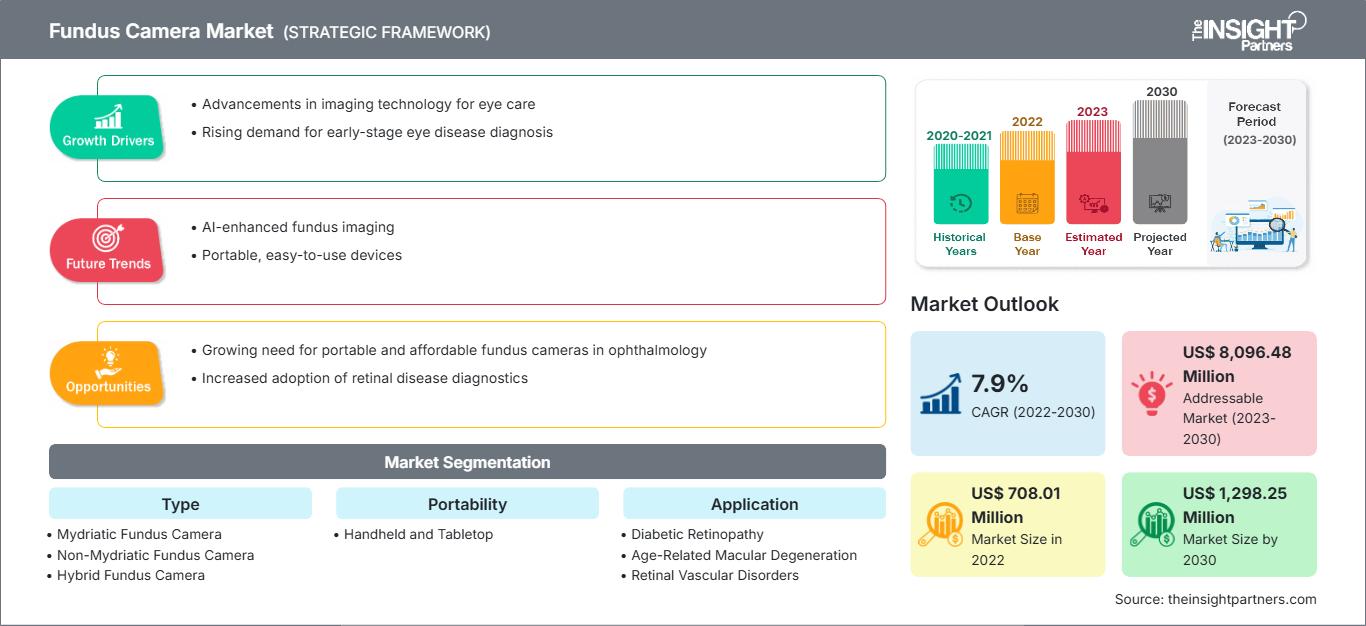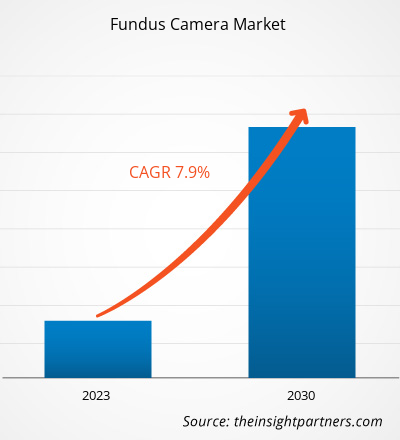[研究报告] 眼底照相机市场规模预计将从 2022 年的 7.0801 亿美元增长到 2030 年的 12.9825 亿美元;预计 2020 年至 2030 年的复合年增长率为 7.9%。
分析师观点
眼底照相机市场分析包括糖尿病视网膜病变筛查程序的增加和创新产品的推出等驱动因素。此外,人工智能与眼底镜的结合是 2020 年至 2030 年市场增长的未来趋势。根据报告中按类型细分的细分情况,免散瞳眼底照相机细分市场在 2022 年占据最大份额。在便携性方面,台式细分市场占据最大份额,占据主导地位。从应用角度来看,糖尿病视网膜病变领域将占据眼底照相机相当大的份额,并在预测期内引领市场增长。从最终用户来看,预计眼科中心领域将在2020年至2030年期间占据眼底照相机市场增长的最大份额。
眼底照相机是一款专用低倍显微镜,配备摄像头,其光学设计基于间接检眼镜。眼底照相对于诊断和治疗各种后段和其他眼部疾病至关重要。因此,眼底照相机是便携式且比台式照相机更经济的替代品。例如,两款眼底照相机(Pictor 和 Remidio)显示出比台式设备更高的图像采集成功率、更高的图像质量和可升级性。
市场洞察
创新产品发布
自定义此报告以满足您的要求
您将免费获得任何报告的定制,包括本报告的部分内容,或国家级分析、Excel 数据包,以及为初创企业和大学提供超值优惠和折扣
眼底照相机市场: 战略洞察

- 获取本报告的主要市场趋势。这个免费样本将包括数据分析,从市场趋势到估计和预测。
您将免费获得任何报告的定制,包括本报告的部分内容,或国家级分析、Excel 数据包,以及为初创企业和大学提供超值优惠和折扣
眼底照相机市场: 战略洞察

- 获取本报告的主要市场趋势。这个免费样本将包括数据分析,从市场趋势到估计和预测。
医疗器械公司专注于新产品的开发和发布,并获得相应监管机构的批准。以下列举了一些促进全球眼底市场发展的最新进展。
2021年10月,尼德克公司宣布推出“Retina Scan Duo 2”,这是一款结合了光学相干断层扫描 (OCT) 和眼底照相机的系统。这款新产品凭借其用户友好的功能,有助于增强眼部筛查和临床效率。Retina Scan Duo 2 采用了一种新颖的图像增强技术,可将单帧图像生成高清图像,从而确保患者获得极佳的舒适度。
2023年1月,领先的医疗设备和软件解决方案提供商 Topcon Healthcare 宣布推出“NW500”,这是一款用户友好的机器人眼底照相机,能够提供可靠且清晰的图像。这款新产品还简化了诊断实验室的工作流程,提升了患者体验,并使筛查人员能够在光线充足的环境中获取视网膜图像。此外,他们无需要求患者散瞳。此外,该产品可在三个传统注视点(视盘、中心和黄斑)以及用于周边摄影的九个注视点提供优质的彩色眼底图像。
2021年6月,Coburn Technologies宣布推出由Huvitz有限公司生产的新型视网膜照相机HFC-1免散瞳眼底照相机。凭借高精度的自动检测技术,该产品旨在提供清晰、快速、可靠的视网膜成像和测量结果。
AI与眼底镜的集成
基于彩色眼底照片的AI诊断系统在糖尿病视网膜病变筛查中表现出最佳的灵敏度和特异性。在中国,中国医药教育协会智能医学专业委员会人工智能眼科学组已经起草并通过了《基于眼底照相的人工智能糖尿病视网膜病变筛查系统》指南。支持制定AI辅助DR筛查统一标准,推动AI诊断系统在临床的应用,提高糖尿病视网膜病变诊治水平。专家组还从系统硬件参数、设备配置、数据采集及标准、数据库建立、AI算法要求、AI筛查报告内容及格式、AI筛查随访计划等方面,制定了基于眼底照片的AI辅助糖尿病视网膜病变筛查平台的规范和建议。
报告细分及范围
基于类型的洞察
眼底照相机市场按类型细分为散瞳眼底照相机、免散瞳眼底照相机、混合眼底照相机和ROP眼底照相机。免散瞳眼底照相机在2022年占据最大市场份额。散瞳眼底照相机对眼底照相机市场贡献了显著的复合年增长率。免散瞳眼底照相机专注于通过仪器的低倍显微镜,在不增大瞳孔的情况下,对视神经乳头、视网膜和晶状体进行高清图像采集。与散瞳眼底照相机相比,免散瞳眼底照相机最显著的优势之一在于其革命性的升级,无需散瞳即可采集更大更清晰的图像。此外,免散瞳眼底照相机操作简便,无需患者眨眼后等待30分钟散瞳和调整眼部,从而帮助眼科医生提高诊断效率。
CX-1 混合数码散瞳/免散瞳 (MYD/NM) 眼底照相机是佳能首款采用眼底自发荧光 (FAF) 摄影技术的混合型免散瞳照相机。 CX-1 提供五种拍摄模式——彩色、无红、钴蓝、荧光素血管造影 (FA) 和眼底自发荧光 (FAF)。
此外,我们还成功开发了一款独立的散瞳眼底照相机原型,该原型照相机能够以傻瓜相机的方式操作。此外,散瞳眼底照相机可自动对焦和曝光,其眼底照片的图像质量可与现有的商用相机媲美。例如,散瞳眼底照相机对于筛查糖尿病视网膜病变和老年性黄斑变性患者具有重要意义,因为这些患者很容易从眼底图像中识别出来。
2020 年 10 月,Volk Optical 宣布推出一款用于眼底成像的新型便携式散瞳视网膜照相机“Volk VistaView”。新推出的产品通过直观的数字平台提供高分辨率、全玻璃、双非球面光学元件,可捕捉清晰的广角图像并在设备上管理患者数据。
基于便携性的洞察
根据便携性,全球眼底照相机市场分为手持式和台式。台式部分在 2022 年占据了更大的市场份额。预计手持式部分在 2020 年至 2030 年期间的复合年增长率将更高。眼底照相有助于检测和筛查各种可治疗和可预防失明的原因,特别是糖尿病视网膜病变 (DR)、年龄相关性黄斑变性、青光眼和早产儿视网膜病变。手持式照相机是一种更小的便携式成像设备。该工具由电池供电,操作无需支架或桌子。手持式照相机往往比台式照相机更实惠。便携性和低成本使得视网膜成像设备更容易获得。手持式眼底照相机可用于家庭、流动诊所和健康博览会。
现代手持式眼底照相机与自主人工智能系统相结合,由于其高灵敏度和图像质量,非常适合无需散瞳的 DR 筛查。然而,这些照相机的特异性需要通过更好的数据建模来提高。美国俄亥俄州门托市的 Volk iNview 眼底照相机可通过应用程序连接到 iPhone 6s/6/5s 或 iPod Touch(第六代)。Volk Pictor Plus 是一款免散瞳眼底照相机,配备后视(视网膜)和前视成像模块;该照相机使用专有镜头,可下载应用程序拍摄眼底图像。手持式相机现在正成为一种新的低成本 DR 筛查工具,可以方便无法获得眼科护理的患者使用。
基于应用的见解
就应用而言,眼底相机市场细分为糖尿病视网膜病变、年龄相关性黄斑变性、视网膜血管疾病等。糖尿病视网膜病变部分在 2022 年占据了眼底相机最大的市场份额。糖尿病 (DM) 被认为是一种流行疾病。根据糖尿病研究所的数据,目前美国有 3730 万人患有糖尿病。
糖尿病视网膜病变 (DR) 是糖尿病最严重的长期并发症之一,也是 20-74 岁人群失明的主要原因。截至 2020 年,美国患有糖尿病视网膜病变的成年人数约为 800 万;预计到 2050 年将达到 1600 万。它可以是增生性(正在生长)或非增生性(不生长),指的是视网膜中出现异常血管。非增生性视网膜病变更为常见,可能不需要治疗。在增生性视网膜病变中,当正常血管被切断时,异常血管开始形成。增生性视网膜病变可能导致视力丧失。应通过常规眼科检查监测视网膜病变从非增生期到增生期的进程。眼底照相对于管理和记录糖尿病眼病至关重要。传统上,眼底照相使用胶片进行,但最近,数字眼底照相已获得显著的关注。数字图像可以轻松即时地查看图像、直接放大图像,并能够轻松验证图像。
基于最终用户的见解
按最终用户细分,市场分为医院、眼科中心和其他。眼科中心细分市场在 2022 年占据最大市场份额,并将在 2020 年至 2030 年期间实现最高复合年增长率。
区域分析
北美占据眼底照相机市场的主导地位,占有最大份额。在北美,美国是眼底照相机的最大市场。根据美国疾病控制与预防中心的数据,年龄相关性黄斑变性 (AMD) 是 65 岁及以上美国人失明和视力丧失的主要原因。据 CDC 称,预计美国老年人口将从 2015 年的 4800 万增加近一倍至 2050 年的 8800 万。美国近 2000 万成年人患有某种形式的年龄相关性黄斑变性。
DR 是糖尿病患者中常见的一种并发症。根据国际糖尿病联合会 (IDF) 的数据,2021 年全球约有 5.37 亿成年人(20-79 岁)患有糖尿病。该机构还报告称,到 2030 年,糖尿病患者总数预计将增至 6.43 亿。此外,美国儿童眼科和斜视协会 (AAPOS) 的研究(更新于 2023 年 4 月)分析显示,美国每年约有 390 万婴儿患有早产视网膜病变。其中,约有 1.4 万名婴儿患有此病,90% 的患儿病情轻微,近 1100-1500 名患儿病情严重,需要接受治疗。因此,早产儿视网膜病变、糖尿病性视网膜病变 (DR) 和年龄相关性黄斑变性在人群中的患病率上升,推动了美国眼底照相机市场的增长。
本报告介绍了全球眼底照相机市场的领先企业,包括尼康公司、拓普康公司、尼德克有限公司、佳能公司、卡尔蔡司公司、Visionix USA Inc、Kowa Co Ltd、CenterVue SpA、Volk Optical Inc 和 Digital Eye Center。
眼底照相机市场区域洞察
The Insight Partners 的分析师已详尽阐述了预测期内影响眼底照相机市场的区域趋势和因素。本节还讨论了北美、欧洲、亚太地区、中东和非洲以及南美和中美洲的眼底照相机市场细分和地域分布。
眼底照相机市场报告范围
| 报告属性 | 细节 |
|---|---|
| 市场规模 2022 | US$ 708.01 Million |
| 市场规模 2030 | US$ 1,298.25 Million |
| 全球复合年增长率 (2022 - 2030) | 7.9% |
| 历史数据 | 2020-2021 |
| 预测期 | 2023-2030 |
| 涵盖的领域 |
By 类型
|
| 覆盖地区和国家 | 北美
|
| 市场领导者和主要公司简介 |
|
眼底照相机市场参与者密度:了解其对业务动态的影响
眼底照相机市场正在快速增长,这得益于终端用户需求的不断增长,而这些需求的驱动因素包括消费者偏好的演变、技术进步以及对产品优势的认知度的提升。随着需求的增长,企业正在扩展其产品线,不断创新以满足消费者需求,并抓住新兴趋势,从而进一步推动市场增长。

- 获取 眼底照相机市场 主要参与者概述
- 2022年10月,Topcon Healthcare宣布推出NW500——一款全新的全自动免散瞳视网膜照相机,可提供可靠、清晰的图像质量和增强的功能。
- 2021年8月,跨国公司Thirona BV与尼德克株式会社(NIDEK CO., LTD.)合作,实现了Thirona的RetCAD人工智能眼病检测软件与尼德克的NAVIS-EX图像归档软件之间的互联互通。该互联互通功能允许通过尼德克AFC-330和Retina Scan Duo采集的彩色眼底图像,即时筛查老年性黄斑变性(AMD)和糖尿病视网膜病变(DR)。
- 2023年2月,尼德克株式会社与光学技术创新领导者豪雅视力保健(HOYA Vision Care)达成合作。两家公司之间的全球协议将为眼科护理专业人员 (ECP) 提供全套尖端光学仪器和产品,为患者提供全方位的患者护理,从眼科检查到咨询,再到提供高质量的眼镜片。
- 2022 年 7 月,佳能医疗系统美国公司完成了对 NXC Imaging 的收购,NXC Imaging 是一家总部位于明尼苏达州明尼阿波利斯的医疗成像设备分销商和服务提供商,以扩大其在中西部上游地区的销售和服务范围。因此,佳能医疗计划为该地区建立一个规模庞大的销售和服务机构,提供尖端解决方案和根据每个客户的特定需求定制的独特商业模式。
公司简介
- 尼康公司
- Topcon 公司
- NIDEK 有限公司
- 佳能公司
- 卡尔蔡司公司
- Visionix 美国公司
- Kowa 有限公司
- CenterVue SpA
- Volk Optical 公司
- 数字眼科中心
- 历史分析(2 年)、基准年、预测(7 年)及复合年增长率
- PEST和SWOT分析
- 市场规模、价值/数量 - 全球、区域、国家
- 行业和竞争格局
- Excel 数据集
近期报告
相关报告
客户评价
购买理由
- 明智的决策
- 了解市场动态
- 竞争分析
- 客户洞察
- 市场预测
- 风险规避
- 战略规划
- 投资论证
- 识别新兴市场
- 优化营销策略
- 提升运营效率
- 顺应监管趋势




















 获取免费样品 - 眼底照相机市场
获取免费样品 - 眼底照相机市场